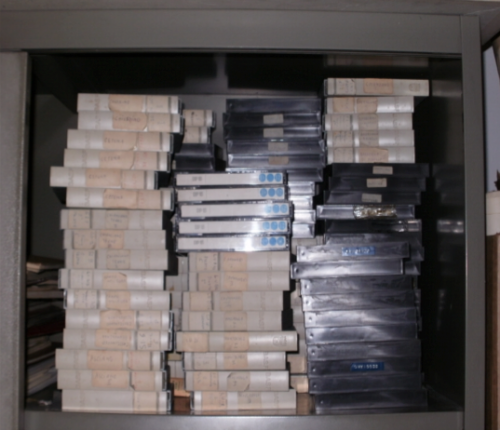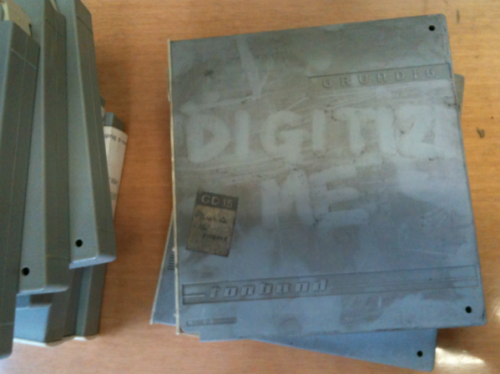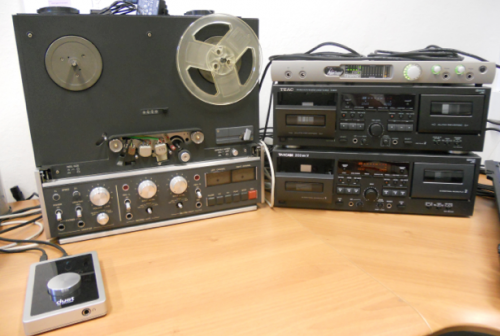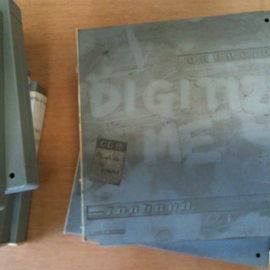Italian language diversity has no equal in Europe (Loporcaro 2009). Post-unification Italy underwent a heavy process of linguistic standardization and dialect erosion that was considered by many to be necessary and inevitable.
Italy preferred replacing dialects with a national language rather than establishing a stable multilingual repertoire, which caused the reduction of glotto-diversity (De Mauro 1963). Very few intellectuals fought this process. One distinguished exception was Pier Paolo Pasolini, who repeatedly stood up for popular culture and its vehicle, dialect.
As a young linguistics student, I often visited a room at my university in which hundreds of old tape reels and accompanying materials were stored. They came from an extraordinary geo-linguistic project carried out during the late postwar period in Italy, called the Carta dei Dialetti Italiani (CDI). The CDI project provided a detailed picture of the dialects of Italy that existed in the early 20th century, which were captured through interviews with individuals middle-aged or elderly at the time. The archive collection holds approximately 1,100 open reels —accompanied by written reports —corresponding to nearly 1,600 hours of recorded speech. The CDI archive is a unique treasure that remains sorely underused and inaccessible to the scientific community.

That room had also hosted the staff of another geo-linguistic enterprise in the 19XXs: the Atlante Lessicale Toscano, a database of the Tuscan lexicon. I went there many times in order to consult different theses and reports and to leaf through the pages of the fieldwork memoranda taken in the 1960s and 1970s in order to glean their secrets. I was meditating on the fieldwork carried out by others, and at the same time I began my own fieldwork on the vernacular speech of a very small community in Maremma, Tuscany. I observed, interviewed, collected, and recorded hours and hours of speech, transcribing the most relevant parts myself.
At the time, I met several colleagues working in my field who told me that transcriptions were considered much more important than the recordings themselves; many simply threw away their reels and compact cassettes once a transcription was completed. Analysis was deemed more essential than unrefined data. As one famous Italian scholar wrote to me when I expressed the importance of fieldwork: “Dear Miss Calamai, I have to remind you that one thing is to analyse data and another is just collecting”. At that time, the case for the importance of preservation, re-use, and accessibility of sound archives had not yet been made.
I wondered about the destiny of all the recordings collected in the field by linguists and other scholars: thousands of hours of speech recordings gathered for different purposes (e.g., linguistics, anthropology, social sciences, oral history, musicology, …). Despite having been digitally preserved, many were still inaccessible to the source communities themselves, not to mention a wider audience.
From the CDI to Grammo-foni project
Let us turn to the CDI project again. The enterprise—conceived and directed by Oronzo Parlangèli (University of Bari)—was originally designed as a survey on 500 voices and the collection of a dialectal version of the “Parable of the Prodigal Son” from every Italian municipality (Parlangèli 1972). Nowadays, it still represents one of the most important projects of dialectal material collection of the last post-war period. The project was characterized by the systematic use of the tape recorder and by the determination to preserve the sound material collected. After Parlangèli's unexpected death, the CDI research centre, established by the National Council of Research (CNR), moved from Bari to Padua under the direction of Manlio Cortelazzo. Unfortunately, the materials were then dispersed among the CNR's Padua Centre of Dialectology, the University of Bari, the Colombaria Academy in Florence, and to some of the researchers who took part in the project. The recorded materials were at risk of deterioration, as many of them were affected by well-known “diseases” such as sticky-shed syndrome, soft-binder syndrome, or loss of lubricant. It was crucial that someone intervene before it was too late.

"Digitize Me." Photo: S. Calamai.
An “official” inventory of all the sound and paper materials of the CDI, which remains a unique collection in European dialectology, has not yet been realized. The only inventory updated to 2011 was conducted by myself and my colleague Pier Marco Bertinetto (2012): with CNR's consent, we gathered together in the Scuola Normale Superiore Linguistics Laboratory all of the materials scattered throughout the Italian peninsula. Our goal was to preserve and disseminate this intangible cultural material, while stimulating reflection on the importance of returning publicly funded research to the citizens: the CDI audio reels. The CDI audio reels were forgotten for almost 40 years by the Italian scientific community, despite the fact that the enterprise had received public funding. The CDI represents an unfortunate page in the history of Italian linguistics and shows that full recognition and appreciation of oral documents collected in recent decades is still far from being achieved.
Since the development of the UNESCO Convention for the Safeguarding of the Intangible Cultural Heritage (2003) and the widespread use of the term “intangible cultural heritage”, the importance of digitization, cataloguing and dissemination of research has become clearer and more comfortable to many. Yet uncertainty endures and some scholars still prefer to keep their cassettes safe in their drawer and their .wav files in their personal data storage.
In 2011, the Region of Tuscany provided financial support to Pier Marco Bertinetto and I for a two-year project called Grammo-foni. Le soffitte della voce (Gra.fo), to create an archive combining the main oral archives of the region. Tuscany is a privileged area for working on oral documents, as it abounds with both public and private sound archives, collected in different fields of research by both scholars and amateurs. The majority of these archives are analog and therefore risk deterioration unless they are transferred to the digital domain.
This project was jointly conducted by the Scuola Normale Superiore and the University of Siena (Regione Toscana PAR FAS 2007-13). Although we conceived of the project as linguists, we immediately realized how cross-disciplinary it was, and that we needed help from several disciplines. It has been necessary to lay the foundations for an interdisciplinary dialogue between linguistics, law, anthropology, informatics, and archival science. The Gra.fo project has undertaken the challenging task of gathering different kinds of expertise and building a digitization and cataloguing system with the aim of creating a regional network for the management of sound archives. With over 2,800 hours of digitized recordings and an incredibly vast range of document types (biographies, linguistic questionnaires, folk songs, questionnaires, lullabies, etc.) and topics covered (history, politics, economy, anthropology, linguistics, folk literature, etc.), the Gra.fo archive is a unique and exemplary accomplishment in the Italian panorama (Calamai et al. 2013).

Photo: S. Calamai.
From safeguarding to dissemination
Conflicting issues arise when dealing with intangible cultural heritage, as the demand for open access conflicts with ownership rights and ethical issues. My research on sound archives has begun to analyze the possibility of reaching a balance between two conflicting demands: the need for ICH openness and accessibility vs. the respect of all the rights related to ICH, including copyright, intellectual property, privacy law.
In the last few years of my academic work, I have devoted special attention to the issue of disseminating oral heritage via new technologies. This requires a thorough reflection not only from the technological point of view, but also from the legal one, since most of our oral heritage recordings were collected at a time when little or no attention was paid to the legal aspects of ICH. Some of the challenging questions we now face are: how can we reach each and every voice (or his/her descendant) upon whom books, conference proceedings and articles have been written? How can we overcome their discomfort with making their interview available? How can we communicate the relevance of such oral testimonies to non-academics? How can we give them back the voices, the stories and the knowledge involved in the recorded narratives?
Ultimately, what I am trying to do is to give sound archives of the past a new life, that is, to return a voice to the hundreds of peasants, workmen, workingwomen and housewives who built the recent history of Tuscany, Italy.
*All images used with the permission of Silvia Calamai.
REFERENCES CITED
Calamai, S. and Bertinetto, P.M. 2012. Per il recupero della Carta dei Dialetti Italiani. In Coesistenze linguistiche nell'Italia pre- e postunitaria, edited by T. Telmon, G. Raimondi, L. Revelli. Atti del XLV Congresso internazionale di studi della Società di Linguistica Italiana (Aosta/Bard/Torino 26-28 settembre 2011), 2 voll., Roma, Bulzoni: 335-356.
Calamai, S., Biliotti, F., Bertinetto, P.M., Bertini, C., Ricci, I., Scuotri, G. 2013. The Gra.fo sound archive: architecture, methods and purpose. In Proceedings of the 2013 Digital Heritage International Congress (DigitalHeritage), edited by A.C. Addison, G. Guidi, L. De Luca, S. Pescarin. Institute of Electrical and Electronics Engineers Inc.: 439.
De Mauro, T. 1963 Storia linguistica dell’Italia unita, Roma-Bari, Laterza.
Loporcaro, M. 2009 Profilo linguistico dei dialetti italiani, Roma-Bari, Laterza.
Parlangèli, O. 1972 Scritti di dialettologia, Galatina, Congedo.
Silvia Calamai is an Associate Professor of Linguistics at the University of Siena, and an IPinCH Associate.






